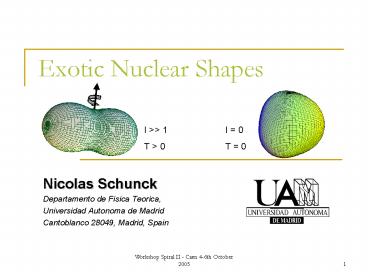Exotic Nuclear Shapes - PowerPoint PPT Presentation
1 / 21
Title:
Exotic Nuclear Shapes
Description:
Synthetic inorganic-organic compound with ZnO4 tetrahedral clusters ... Universit Libre de Bruxelles, Bruxelles, Belgium. University of Surrey, Guildford, UK ... – PowerPoint PPT presentation
Number of Views:121
Avg rating:3.0/5.0
Title: Exotic Nuclear Shapes
1
Exotic Nuclear Shapes
I 0 T 0
I gtgt 1 T gt 0
- Nicolas Schunck
- Departamento de Fisica Teorica,
- Universidad Autonoma de Madrid
- Cantoblanco 28049, Madrid, Spain
2
Standard Nuclear Shapes
- Types of nuclear shapes
- Spherical
- Prolate
- Oblate
- Tri-axial
- Pear-shape
3
Point Symmetries in the Microscopic World
- Synthetic inorganic-organic compound with ZnO4
tetrahedral clusters linked by C6H4-C-O2 struts
(Li, Nature, 1999). - 1.29 nm spacing between centers of adjacent
clusters.
4
Point Symmetries and Nuclear Stability
- Shell Gaps ? Stable configurations
- In nuclei Higher degeneracies ? Larger
shell gaps
Degeneracies are a direct consequence of the
underlying point symmetry of the shape
5
Point Groups and Level Degeneracy
Survey of the properties of a few point groups
6
Symmetry Groups Td and Oh
- Parameterization of the shape symmetries
- Tetrahedral a32 ? 0
- Octahedral a40, a44 ? 0
- Other possibilities involving higher order
multipoles a?µ
7
Tetrahedral Shell Gaps
8
Tetrahedral Shell Effects
9
Neutron-rich Zr Isotopes
10
Tetrahedral Magic Numbers
- From a WS potential
- 20, 32, 40, 56-58, 64, 70, 90, 100, 112,
- Existence of Td magic numbers independent of the
realization of the mean-field
Universality
Yb isotopes
Zr isotopes
Best candidates proton-rich or neutron-rich
nuclei
11
Experimental signatures (1/2)
- Stable tetrahedral minimum Shape isomer
- Low-spin physics dont expect I gt 10 h
- Possibly high excitation energy
- Static octupole moment Q3
- No dipole moment
12
Experimental signatures (2/2)
- Weak collective rotation
- Yrast traps with parity doublet ? (because of
parity-breaking) - Bunch of quasi-particle excitations (because of
the 4-fold degeneracy of s.p. levels) - Investigations under way
- RPA (Strasbourg)
- GCM (Warsaw)
- Spectroscopy with point symmetries (Lublin)
13
Summary (for Part I)
- Mean-field Theories predict tetrahedral
configurations in islands of nuclei throughout
the nuclear chart - Low-lying states (by opposition to cluster
states) - New types of shape coexistence prolate, oblate,
spherical, tetrahedral, octahedral, pear-shaped,
etc. - The best candidates will be found away from the
valley of stability
The nuclear tetrahedral symmetry reflects the
quantal nature of the nucleus (always competing
with the macroscopic, liquid-drop aspects)
14
Deformed nuclei in motion
Consequence of the breaking of the rotational
invariance deformed nuclei can rotate
Example of a super-deformed rotational band
Jacobi Shape transition
15
The Jacobi Shape Transition
Example of the Jacobi shape transition in 152Dy
16
The various forms of the Jacobi transition
Instability of the Jacobi transition leading to
fission
17
Jacobi transition and Hyper-deformation
Liquid drop High-temperature Limit
18
Hyper-deformed configurations
- Neat Jacobi Transition a prerequisite for
populating SD and HD states - Mean-field at the limits
- Single-particle structure
- Effective interaction
- Jacobi Shapes and many-body problem
19
Summary (Part II)
- Hyper-deformation (and Jacobi shapes) can be
observed only at very high angular momentum - Short spin-window in-between the Jacobi
transition and fission - Mass A 100 among the best candidates
The Jacobi shape transition reflects the
macroscopic, liquid-drop nature of the nucleus
(always competing with the quantal aspects)
20
Collaboration Network
- IReS-ULP, Strasbourg, France
- Institute of Theoretical Physics, Warsaw
University, Poland - University Marie Curie-Sklodowska, Lublin, Poland
- University of Notre Dame, USA
- Université Libre de Bruxelles, Bruxelles, Belgium
- University of Surrey, Guildford, UK
- Niels Bohr Institute, Copenhagen, Denmark
- Henrik Niewodniczanski Institute of Nuclear
Physics, Kraków, Poland
21
Bibliography
- X. Li, J. Dudek, Phys. Rev. C49 (1994) 1250(R)
- S. Takami , K. Yabana, M. Matsuo, Phys. Lett.
B431 (1998) 242-248 - M. Yamagami, K. Matsuyanagi, M. Matsuo, Nucl.
Phys. A693 (2001) 579-602 - J. Dudek, A. Gózdz, N. Schunck and M. Miskiewicz,
Phys. Rev. Lett. 88 (2002) 252502 - J. Dudek, A. Gózdz and N. Schunck, Act. Phys.
Pol. B34 2491 (2003) - N. Schunck, J. Dudek, A. Gózdz, P. Regan, Phys.
Rev. C69 (2004) 061305(R)































